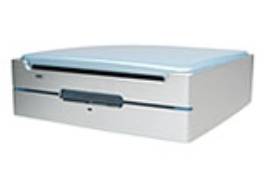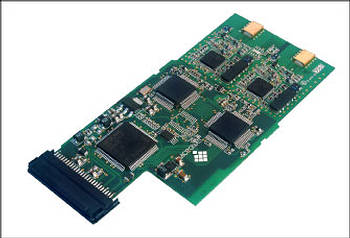 |
||
|
||
| ||
Intel Santa Rosa SFF Platform To Shape Future Design For The Desktop Micronas Introduces Dual-Tuner DVB-T ExpressCard 54 Reference Design For Notebooks Universal Abit To Unveil A HDMI Motherboard NVIDIA And Alienware Showcase SLI Notebook With Dual GeForce Go 7900 SanDisk Introduces RapidGX, Memory Stick Pro Duo Gaming Card For Sony PSP Intel Santa Rosa SFF Platform To Shape Future Design For The Desktop Scheduled to debut in the first quarter of 2007, Intel’s Santa Rosa platform will utilize the Core2 Duo mobile processor, previously code-named Merom, for small-form-factor implementations for t he desktop. SFF PC manufacturers indicated that Intel’s intention is to use the new processor core to narrow the gap between notebooks and desktops in performance, power consumption and heat dissipation, in an integrated architecture for the PC. Santa Rosa will be key to revolutionizing the size and design of PCs in the future, according to PC makers, who also mentioned Intel’s so-called “Mobile on DeskTop (MoDT)” project, another Intel-promoted term originally proposed by the Taiwan PC industry. Intel intends to push “MoDT”, which was previously titled the “Mobile in Desktop Platform,” as a concept for mini PCs featuring its Core Duo technology. The term “MoDT” was initiated by AOpen in 2004, according to the company website, which indicates how MoDT-compliant products incorporate standards-based notebook components in traditional desktop platforms. With power consumption lower than that of an ordinary desktop, the new type of PC enables a shrink of the form factor. The MoDT concept brings together Windows XP Media Center Edition, a flat-panel display and other high-end components, at the center of a home-entertainment system. Intel’s Core Duo CPUs are not mentioned as the only processors that could be selected for AOpen’s “MoDT” solutions, nor do AOpen’s designs incorporate Intel’s “Viiv” digital-home platform. However, to date, AOpen has only adopted Intel processors for MoDT-compliant products.  According to Intel Taiwan, “MoDT” is not an official product name introduced by the company, but a term for non-notebook PC applications that feature mobile processors with low power consumption, especially for SFF PCs. “MoDT” is just one type of product design that Intel and other industry players are currently developing to meet specific usage models and purposes, but there are also other ways to design and produce products that meet the needs of a very diversified market. Intel presented the AOpen MP945-VX, an SFF PC incorporating its Core Duo processors with the Viiv platform, at the Intel Developer Forum (IDF) in San Francisco in early March, according to an AOpen March 6 press release. AOpen said it will begin shipping the MP945-VX in volume from next week. According to International Data Corporation (IDC), digital-home applications will be key to triggering future demand for PCs, which will adopt ever smaller form factors. PCs currently come in a variety of form factors, including Tower, Mini Tower, All in One, Entertainment PC, Ultra Sleek and Mini PC, but demand for small-sized systems, including Media Center, SFF and ultra SFF PCs, will continue to grow through 2009, whereas the Tower and Mini Tower markets will see some decline. Source: DigiTimes
Micronas Introduces Dual-Tuner DVB-T ExpressCard 54 Reference Design For Notebooks Micronas announced the launch of MicMamba2D-XC, a dual-tuner DVB-T ExpressCard 54 reference design for notebook computers. MicMamba 2D-XC has two independent tuners on a single card. This allows notebook users to watch one program while recording another, delivering full PVR functionality in the user’s notebook computer. The notebook can now double as a portable TV or full media center. The dual-tuner design offers a second advantage -– the card can combine the signals from both tuners to increase signal quality while moving, or in marginal-reception areas. This capability, commonly called “antenna diversity”, is based on the patented ‘Maximum Ratio Combining’ technology, licensed from Rohde and Schwarz.  MicMamba 2D-XC is built on the ExpressCard 54 form factor, the new standard for notebook computers based on PCI Express, and uses the native PCI Express mode. Furthermore, MicMamba 2D-XC uses a low-differential PCI Express signaling voltage, much above the DVB-T frequency spectrum (2.5 GHz), to minimize interference into the tuner. Other bus standards like PCI (single ended 33 MHz) and USB 2.0 (480 MHz) are prone to interfere with the tuner. The small size and low power consumption of MicMamba 2D-XC means it fits into the new generation of PCI Express-based notebook computers easily and delivers long battery life. MicMamba 2D-XC uses the DRX 3976D COFDM demodulator and exceeds all requirements of the NorDig-Unified v1.0.2 Receiver Specification. It allows a single design to be compatible with all DVB-T standards worldwide. The built-in diversity mode of DRX 3976D uses Maximum Ratio Combining technology. MicMamba 2D-XC also features the nGene APB 7202A PCI Express controller from Micronas and a MicroTuner MT2060 digital TV tuner from Microtune. In a first for a PC Card TV class product, MicMamba 2D-XC is CENELEC-compliant. CENELEC sets very rigorous standards for electrical interference, and is a requirement for equipment sold for use in consumer living rooms. Micronas took this extra step to insure the best possible performance, and also to allow MicMamba 2D-XC to be used anywhere around the home. Micronas’ nGene dual-channel multimedia PCI Express controller is certified by the PCI-SIG, the industry standard body for PCI Express technology, to be PCI Express 1.0a-compliant. MicMamba 2D-XC is the latest member of a family of nGene-based reference designs supported by a common software model. The common software support across the family makes it easy to design world-standard products. MicMamba 2D-XC is is available now. Source: Micronas
Universal Abit To Unveil A HDMI Motherboard DailyTech got word from Universal Abit that the company is on its way to unveil the first HDMI certified motherboard. The motherboard, dubbed Abit IL-80MV, is a 945GT motherboard designed specifically for Yonah (and eventually Merom). The motherboard features a 667MHz front side bus and the ICH7m-DH southbridge. A Core 2 Duo (Merom) processor is capable of taking advantage of the full DDR2 533MHz bus as well. Firewire, dual SATA 3.0Gbps interfaces and optical HDA input/outputs are all standard on the IL-80MV. Of course, the news shocker is that this motherboard features 15-pin D-sub analog and HDMI video out. With the AACS decoder, the HDMI output will support HDCP signals -- making it perfect for a Vista-compatible display or a high definition TV. Most non-HTPC features have been removed on this motherboard, such as a PEG interface. The motherboard does feature a single PCIe x1 lane device, which might make sense for an HDTV Wonder or WiFi adaptor. The final board revision will feature a special OTES cooling solution that is not featured in the preliminary photos we have so far. According to Universal Abit employees, the motherboard is in the final phases of getting AACS certification from Silicon Image. The board is expected to enter into mass production this June, with retail availability that same month. A price for the motherboard has not been set yet, but it is expected to retail on the lower end of 945GT motherboards since most features, like a PCIe x16 adaptor, are not present. Source: DailyTech
NVIDIA And Alienware Showcase SLI Notebook With Dual GeForce Go 7900 NVIDIA announced it will demonstrate Alienware notebooks based on NVIDIA SLI technology -- the world’s first available notebooks to feature dual GeForce Go 7900 series GPUs -- at E3 in Los Angeles. The novelties support resolutions of 1680x1050 and higher and are based on nForce4 SLI core-logic solution. These new enthusiast notebooks, targeted at one of the fastest growing segments of the consumer notebook market, are among the fastest available dual GPU gaming notebooks in the world. The Alienware Aurora mALX notebook with a 19" display will be powered by two top-of-the-line NVIDIA GeForce Go 7900 GTX GPUs. The 17" Alienware Aurora m9700 will be powered by dual high-performance GeForce Go 7900 GS GPUs. Source: NVIDIA
SanDisk Introduces RapidGX, Memory Stick Pro Duo Gaming Card For Sony PSP
The SanDisk RapidGX card comes with software that allows PSP owners to convert and transfer a host of multimedia files from a personal computer to a PSP, through a simple drag-and-drop interface. It also comes with SanDisk’s new MicroMate high-speed Memory Stick PRO Duo card reader, which is optimized for the RapidGX to achieve maximum transfer speeds.
With the MicroMate reader, a PSP user can transfer data at read/write speeds of up to 15MB/s. The reader contains a slot for the card and a USB connector that allows it to be plugged into a PC’s USB port. Since there is no accessible on-board memory in the PSP, all content must be stored on removable Memory Stick PRO Duo cards. Source: SanDisk
Write a comment below. No registration needed!
|
Platform · Video · Multimedia · Mobile · Other || About us & Privacy policy · Twitter · Facebook Copyright © Byrds Research & Publishing, Ltd., 1997–2011. All rights reserved. |